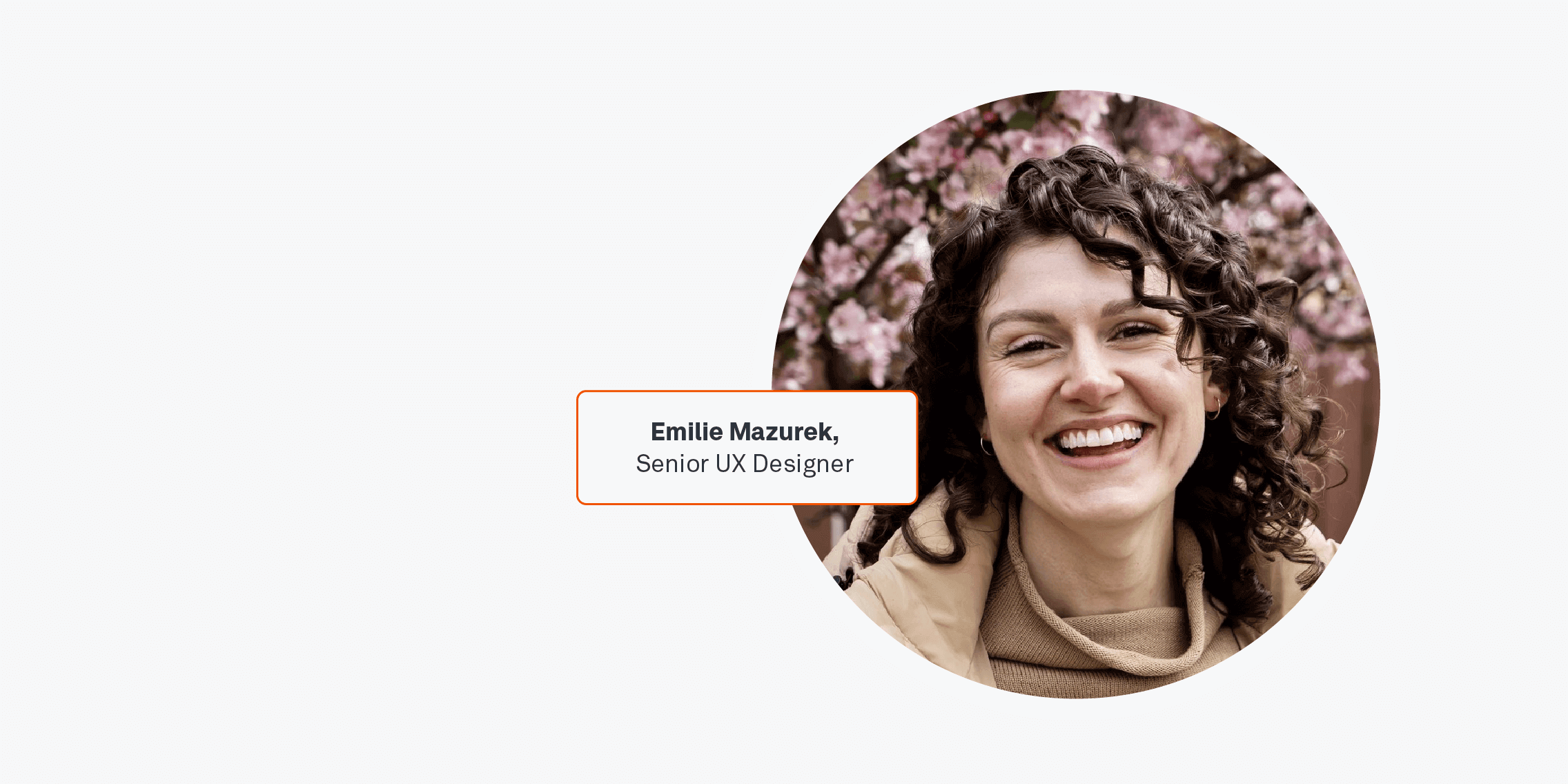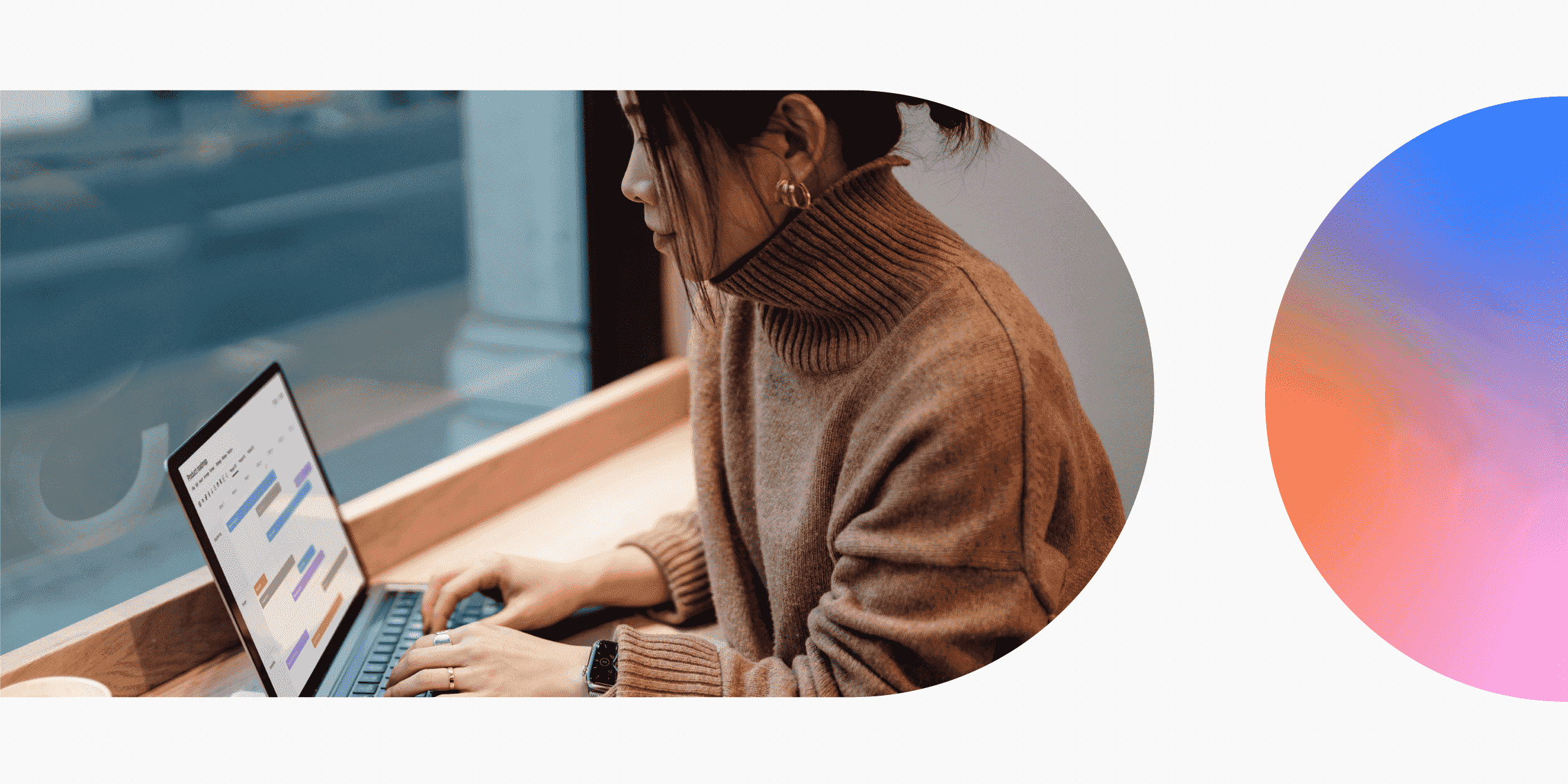In our latest talk on UX Insiders, we sat down with Emilie Mazurek, Senior UX Designer, to hear about her background and how she moved from an unrelated career to UX.
Emilie is from Calgary, Canada, and she initially planned to become a doctor. In fact, she studied Biochemistry at university and even wrote the Medical College Admission Test.
She will take us through every step of her career to date as well as how to transition into UX from a non-UX background including.
How Emilie moved from an unrelated career to UX design
I was starting to be more afraid that I would get into the medical field, rather than get rejected. So I decided this isn’t the path for me or something that’s going to be the best fit. I pursued career counselling because I wanted to make an informed decision. And one of the options that came up that could be a good fit was UX design.
With UX design, there’s this creative problem-solving component to it, which really played to my strengths. As a hospitality worker for over a decade, I got to talk to a wide variety of people on a daily basis and solve their problems for them. While I enjoyed that creative problem-solving side, I just wanted something with a bit more impact.
There’s also this research-driven analytical side of UX that played to my strengths as a scientist. And ultimately, the whole idea is that UX is advocating for the user or helping people. So I ended up receiving my diploma in UX design in April of 2021, landed a job fairly soon after that, and have been working in the industry full-time since then.
I was working as a product designer first at Proposify for a little over a year. I got to be involved in every step of the process from, understanding the problem, and interviewing customers, all the way to the final deliverable, and assessing the impact of our results.
I was also doing some free freelance contract work. So in the evenings, I was working at a startup. They had a website that they didn’t like and they were trying to get money from investors. They wanted to spruce it up. So I was doing more of the visual and branding design for them.
So that’s all great. But you know, you get your diploma, and then what? So I’m going to walk through some of the tips that I found helpful for me in making that transition:
Networking
It’s a huge missed opportunity for not taking advantage of it. I felt like I had to go out and set up all these coffee chats with strangers I didn’t know. And that was really outside of my comfort zone.
But I was looking at it all wrong. Networking is not just about having coffee chats with strangers. It’s just about meeting people, getting to know them, and building a foundation that you can later rely on.
A couple of tips that might be beneficial for you when looking at networking is actually to start early. It’s really about listening to the other person, being curious, and having a genuine conversation with them. That’s how the best relationships are going to get formed. So just go into it with an open mind, be curious, and try to learn about them.
Now I’m using a CRM tool because it’s kind of to the point where I meet people, chat with them, go home, and easily forget. So I found a free template on Notion. You can put the name of the person, where you met them, what the last update was, etc. It might feel like it’s kind of cheating or disingenuous. But it’s much worse to be in a situation where you’re meeting someone again, and you don’t remember what you talked about last time.
On getting a support system
I recommend getting a group of peers from your program or online that are in a similar position to you that you can meet up with on a regular basis, and just discuss your process and progress.
This is something to look forward to. I’m excited to share my progress with them. I’m excited to hear about their progress. It becomes something positive in your schedule that you can look forward to.
Plus, it also helps hold you accountable. I might know I’m meeting four of my friends, and they’ve been on the job search rewriting their resumes, and taking interviews. I’m going to want to be doing the same. So it’s a nice way to push yourself to keep going. Also, it’s really great to learn from each other.
And then it’s a very safe place to vent. So if you want to complain, close friends are a good place to do it. And it’s also good to have hope because you’ll see the progress that everybody is making.
Invest in your application package
This has three parts: a portfolio, a resume, and a cover letter.
Let’s start with the portfolio.
Everybody knows that this is one of the most important things that you’re going to be consistently asked for when you’re applying for your job. You’re going to want to include a handful of case studies on there and represent your personality.
And you’re also going to want to have it be memorable and enticing to your recruiters. That’s often easier said than done. If there’s anything within your control, make sure that’s done to the best of your abilities.
So how can you make sure that your portfolio is done really well? Get feedback and get a lot of it. When I was applying for jobs, I booked multiple sessions on ADPList. I also have a great article that I found revolutionized the way that I looked at putting together a portfolio,
Another thing that you’ll want to keep in mind is the resume. The reality is many hiring managers and recruiters will see your resume long before they ever see your portfolio. As a designer, it’s important that yours is clean, scannable, and designed well, but not over-designed. There’s a very fine line.
And then the last part of your application package is going to be your cover letter. I know nobody loves writing a cover letter. I’m the same. But again, if there’s any way that I can stand out, I’m going to do that. So the cover letter, as much as you want to personalize it for every job, doesn’t necessarily have to be from top to bottom personalized for each job.
The template I used explained my skill set and my background from my resume in more detail to showcase why it was an asset. My background as a biochemist makes me analytical, data-driven, and I can bring that skill set to my UX position. I would also include the reason why I’m looking at this company and this position. So that way it’s still personalized, but manageable at the same time to tailor your cover letter for each application.
How to build a portfolio in UX when you’re working in a different field
Are there any projects that you’ve done that are UX-related?
If you don’t have anything that’s necessarily relevant, that’s a great time to take up passion projects, do a hackathon, or anything like that. It doesn’t necessarily have to be a real experience.
I just want to make it clear that I was able to land my first job with three academic projects on my portfolio. So don’t have so much pressure to have three full case studies working with real companies. Find something that interests you and bring that to the table.
Find what makes you unique
Look at your background. I was in school with all of these graphic designers, and the work they were producing was phenomenal, exponentially better looking than the work I was doing. I was really worried. The reason I got hired at my first position (over somebody with five years of experience in UX because of my background as a scientist) was that they wanted somebody comfortable running experiments and doing A/B testing who understood the scientific method. It became my greatest asset and selling feature. I also use the soft skills that I developed in hospitality every day as a UX designer. Those are the things that are not easy to learn in a program that’s teaching you the fundamentals of UX design.
Organise your search
I 100% recommend using a job tracking tool. I used Huntr, which helped to get me excited about the job process.
The most important thing you can save during your job search is a copy of the job description. Why? Because in UX design, the hiring manager probably wrote that and that’s your golden ticket to who they’re looking for in the role.
For example, if the job description emphasizes they want somebody who’s comfortable with design systems, I’m going to work that into my answer. It can be tricky. They can ask other questions like “What would your colleagues say would be like working with you?” Look at the job description and see what qualities they’re looking for. That’s what you should really highlight.
Build your online presence
Focus on starting small. So let’s just focus on LinkedIn. That’s something that I have a little bit of experience with. Fill out your entire profile because if you don’t fill out your entire profile, your profile may not turn up in search results from recruiters. Even if you don’t think it’s necessarily relevant, it tells your story, it adds value, and it helps with search engine optimization.
To make the most of your skills, consider visiting the profiles of professionals in your desired field to examine the skills they possess. It’s important to note that you shouldn’t feel obligated to include skills that you don’t actually have, but reviewing these profiles can serve as a helpful reminder of your own capabilities and the value you can bring to the table.
Another smart way to tackle this is to go to a job you are interested in having. And a lot of times they will have, you’ve matched seven out of ten of the skills listed for this. You can click on that and see the ten skills they’ve listed. Do that for five or six jobs, you’ll have a good list of the skills you should have on your profile.
One of the most impactful things you can do is actually to get some references. Approach someone you feel comfortable with, and ask them to write about something specific for you.
The last thing you can do is get active. You don’t have to post on LinkedIn if you don’t want to. You can just like and comment on other people’s posts. That’s a great way to get started and legitimately put your name out there.
Get your interview answers ready
Interviews are very predictable as much as they’re intimidating, and many people are not excited about them. But you can get experience with them and practice. The first thing you can do is to look up common UX interview questions on Google. You will probably get asked the majority of these questions in an interview, and you will have an answer prepared that you’ve already thought about.
The next thing is to prepare stories for behavioral questions, ones like “Tell me about a time when X” or “Tell me about a time when you did Y.” But you have to think of an answer on the spot because a lot of these behavioral questions share a similar premise and ask for the same things.
Do some research on what the questions could be like. Have a couple of stories prepared that could be used for different answers. I had four or five stories ready to go for any interview.
The more practice that you get the better. Just record yourself answering the interview questions without your responses written down, and watch it back. You will learn much about how you hold yourself that you might not have recognized before.
Finally, after you’ve practiced enough, it’s time to debrief after the interview. Were there any unexpected questions? Anything that stumped you? Write it down before you forget so that you don’t go into the next interview and have the same problem.
Keep learning and refining your craft
Dive into some topics that maybe didn’t get as much time as you wanted. I was really interested in prototyping and interaction design. So I went and learned how to create LottieFiles and use Adobe After Effects. That was a skill set that I could use that many other designers in my position didn’t have.
You can also look for volunteer experiences. That’s a great way to get hands-on experience that you can put straight on your resume. I competed in a hackathon with my colleagues from school. We didn’t place and it wasn’t the most positive experience for me. But I had a great behavioral interview story I could pull from after. So figure out what’s interesting to you and dive in a bit deeper.
Listen to the feedback you receive
A struggling interviewee might say something like “I’ve applied for more than 150 job listings in the last two months, many interviews, no offers due to salary experience. I’m not giving up.”
The reason for their bad luck is probably their portfolio, resume, or cover letter. That’s the gateway to that next chapter. If you’re getting interviews, but not progressing to the next rounds, you probably need to keep practicing your delivery.
This may indicate that you need to work on your storytelling. Listen to the feedback that you’re receiving and use it to plan your next move.
Take breaks
I’m not saying that it’s all so cut and dry. It can be a lot and it can feel like we put so much pressure on ourselves to always look for the next thing. Don’t burn yourself out.
We don’t perform our best when we’re burning the candle at both ends. Taking a break is okay and you don’t have to feel bad about it.
You don’t have to spend eight hours a day on the job search. You can spend four high-quality hours a day, take a break the rest of the day, and not feel bad about it.
So make sure you’re taking the time that you need for yourself because your mental health is just as important as landing that next role, if not more.




